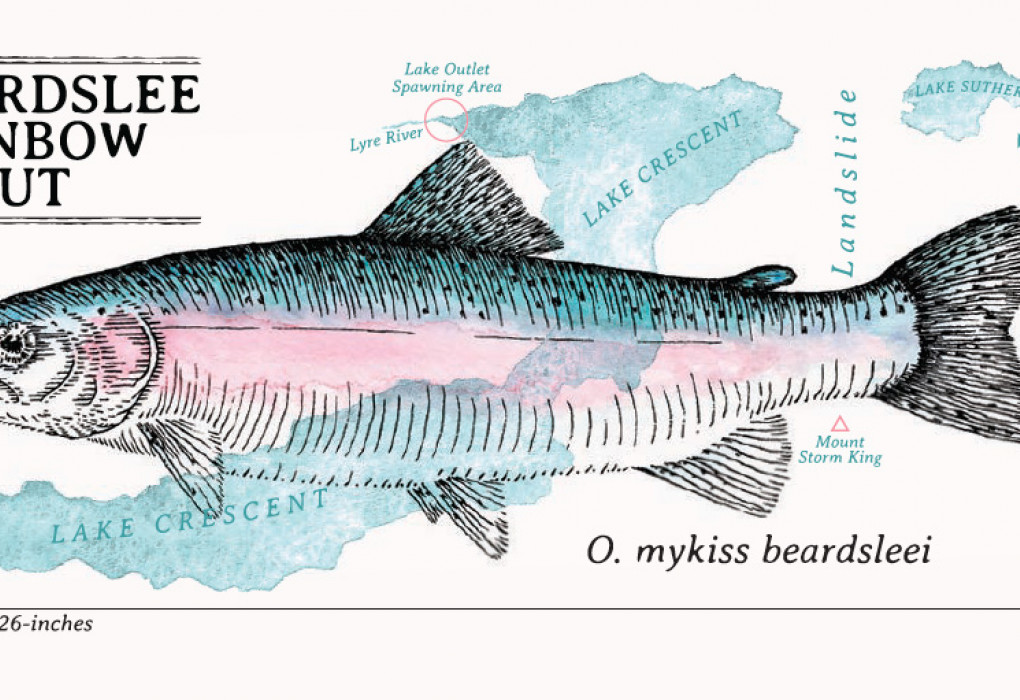Beardslee Trout
Reflections of Place
Seven thousand years ago, Lake Crescent was shaped like a lightning bolt. It drained east from its outlet at Indian Creek to the Elwha River and into the Strait of Juan de Fuca. The geologic past of the big lake would be easy to imagine for a raven flying off of Mount Storm King; at its east end, Crescent’s northern and southern shorelines are keyed to the same horizontal projections as a smaller lake, Sutherland, a mile away. As Highway 101 approaches Lake Crescent, the road grade climbs the remnants of a mountainside, which, seven thousand years ago, was deposited in the middle of the lake by an earthquake so powerful that, if it hit tomorrow, The New Yorker would dub it ‘The Really Big One.’
East of the landslide, Lake Sutherland still drained to the Elwha. West of it, the waterline rose 55 feet before finding a new outlet down the Lyre River, over a falls and, finally, as before, into the Strait of Juan de Fuca.
Those geologic features - the landslide and the Lyre River Falls - had a profound effect on the fish of Lake Crescent: they cut them off from the ocean. Fish that had once been steelhead, sea-run cutthroat and sockeye salmon were landlocked, forced to make a living in a lake so devoid of nutrients that biologists have deemed it ‘ultra-oligotrophic.’ Quantities of nitrogen, phosphorus and other biologically important nutrients are so low in Lake Crescent that, if you find yourself in a boat on a calm day, the water can be unnervingly clear. Naturally, the fish adapted. Surprisingly, they thrived.
The product of 7,000 years of isolation is the Beardslee rainbow trout, a unique population of some of the largest non-anadromous rainbows within their native range. There are records - old records, of course - of Beardslees up 23 pounds. Like most trout, the fish eat whatever aquatic and terrestrial insects can be found in an ultra-oligotrophic lake. However, as they get larger, Beardslees become piscivorous, feeding almost exclusively on the descendants of the lake’s sockeye salmon, kokanee.
The next great change to Lake Crescent came at the turn of the twentieth century. At least 11 different fishing resorts operated along its shorelines. Like anywhere in the American Northwest, turn of the century harvest regulations were liberal. As stocks dwindled, they were supplemented with hatchery plantings of native and non-native salmonids. In addition to coastal cutthroat, rainbows, and kokanee, the lake was stocked with coho salmon, brook trout, lake trout, westslope cutthroat and Yellowstone cutthroat. All told, between 1913 and 1975, Crescent was stocked with 14.3 million hatchery fish. However, bucking the trend of non-native invaders, the stocked fish failed to establish self-sustaining populations. Even lake trout, which are long-lived, eat everything and are decimating native fish species throughout the west, didn’t take.
While the mechanisms responsible for the resilience of native stocks in a body of water like Lake Crescent are still a mystery, at least two studies have shown that Beardslee trout are genetically distinct from other rainbows.
“There is something unique about the fish that are able to live here,” Olympic National Park Biologist Sam Brenkman said. “It speaks to Lake Crescent’s native fish; they are highly-adapted to this environment.”
Today the lake, which falls mostly within the boundaries of Olympic National Park, is managed for the restoration and preservation of its native fish. In 2000, the Park Service changed fishing regulations to catch-and-release only and added a weight restriction to keep Beardslees in deep water from being brought up too fast. Later, at the urging of a Port Angeles resident, the late Dick Goin, they also moved opening day from April to June to protect spawning fish.
By now, spawning habitat is the main thing that keeps Crescent’s fish managers up at night. The Beardslee’s spawning area is confined to the lake outlet above the Lyre River Bridge. It’s unique habit for a rainbow trout. Unlike steelhead, which spawn in moving water all over the Olympic Peninsula, Beardslees only spawn in the lake outlet. Why? There was nowhere else to go. Most of the streams feeding the lake are steep, intermittent and offer little to no spawning and rearing habitat.
The limited spawning area is a double-edged sword for Park Service biologists. Instead of index reaches, the Park Service takes a census of the entire spawning population of Beardslee trout. That data goes back to 1989, the longest-term data set on the Olympic Peninsula. The trade off is that all the eggs - both literal and proverbial - are in one basket.
Of course, everything I’ve said specifically about Beardslee trout is true of wild, native fish in general. It’s just easier to see in a closed system like Lake Crescent. If native fish are cut off from the ocean, they can adapt and thrive in a barren lake. If that lake is devoid of spawning habitat, they can evolve to spawn in stillwater. What’s more, they can thrive there. A wild, native fish is a genetic legacy. Over thousands of years, it has been shaped by its homewaters; it is a perfect reflection of the place it inhabits.
WORDS: Brett Tallman
